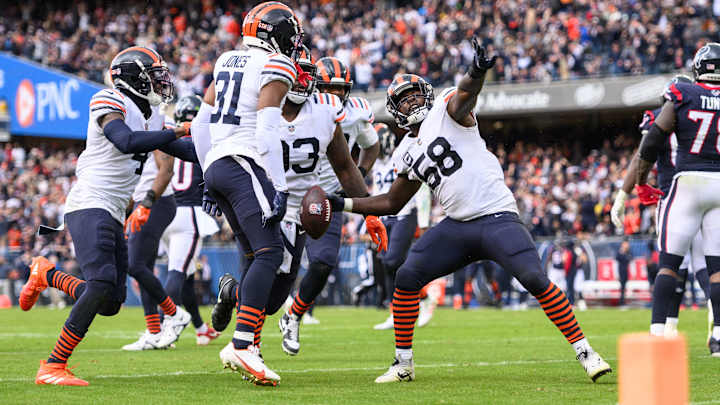What Bears Trading Veterans Really Meant

In this story:
It was easy to look at the trades of Roquan Smith and Robert Quinn at the time they were made and say the compensation would benefit the Bears next year and in the future.
What's apparent now is how much those moves affected the team for this season.
Ryan Poles paid a steep price for the second-round pick acquired for Smith and the Day 3 pick he got for Robert Quinn.
In general terms, the Bears defense seemed to lose its heart, brains and soul with the departure of the two veterans.
Actually, in football and more specific terms, they lost their two best leaders on that side of the ball and the two with the most experience making big plays in big situations.
They needed those qualities to exist in replacements or develop immediately if they were to avoid a negative impact.
While some other players' skills have become more apparent in those players' absences, there hasn't been a pass rusher step up at all to make up for Quinn. At the trade, Quinn had only one sack but occupied the attention of the defense enough that some other players made sacks.
Much has been made of the tackling ability of Jack Sanborn and it's often suggested on social media that the undrafted rookie from Wisconsin/Lake Zurich, Ill. is really outproducing Smith in terms of tackles.
That's all a fallacy based on another fallacy.
Smith didn't even play the same position Sanborn plays. The Bears put Sanborn into Nicholas Morrow's position and moved Morrow to weakside linebacker, where Smith played.
The more accurate comparison would be Morrow's statistics now compared to Smith's before the deal, and Morrow's stats in the middle compared to Sanborn's now.
When they had Morrow and Smith playing together, the tandem was more productive. Smith averaged 10.4 tackles per game, 0.3 sacks, 0.5 tackles for loss and 0.5 interceptions. Morrow did average 6.4 tackles per game and .38 tackles for loss as the middle linebacker.
Morrow averages 5.6 tackles a game with 1.2 tackles for loss on the weakside.
Sanborn's overall stats as midle are better than Morrow's were, with 8.8 tackles to 6.4 and one tackle for loss per game to .38 for Morrow. But Morrow also played three more games at the middle than Sanborn. With normal gravitation torward the mean, Sanborn's numbers are likely to come down closer to what Morrow was doing in the middle.
Meanwhile, the loss of Smith at weakside is much greater. What also must be remembered is this defensive scheme is devised in a way where the weakside isn't supposed to necessarily make more tackles than the middle, but he should have the chance for more big plays.
With Smith playing, they had not only more impactful plays such as sacks and interceptions, but also the most tackles—more than Morrow is making at weakside definitely and even more on average than Sanborn is making at middle linebacker.
Meanwhile, the pass rush situation with Quinn gone has been gradual deterioration. As stated, he had only one sack, but while teams focused attention on him the Bears had two sacks from Trevis Gipson and 1 1/2 from Dominique Robinson. Since he left, Al-Quadin Muhammad made a sack playing Quinn's old position, but neither Robinson nor Gipson has made another sack.
The Bears treat the pass rush as a total team effort. It's the rush men, not the rush man. So totals for the group actually mean more than for one player.
Before the Quinn trade, the Bears had 12 sacks for 79 yards in losses in seven games. After the trade, they have played six games and made four sacks for 23 yards in losses.
The Bears are last in the NFL in sacks (16), have the fewest quarterback knockdowns (15, 4.2%) and going into their bye were last in pressures (70).
The bottom line is they haven't won a game since either of those players left. This is a defense that thrives and is based on taking away the ball. When those two players left, the Bears had taken it away 13 times in eight games. Since then they have two takeaways for five games.
However, they can look ahead with great anticipation to the performances from those two draft picks they will get in the trades, and the benefit derived against the salary cap next year from losing two high-priced veterans off th payroll. Supposedly, it lets them bring in more players.
All of those players will all need to produce because, the Bears gave up an awful lot to bring them here. Considering they had three wins before the first trade and none since, they gave up a season.
TICKETS TO WATCH JUSTIN FIELDS AND THE BEARS THROUGH SI TICKETS
Twitter: BearDigest@BearsOnMaven

Gene Chamberlain has covered the Chicago Bears full time as a beat writer since 1994 and prior to this on a part-time basis for 10 years. He covered the Bears as a beat writer for Suburban Chicago Newspapers, the Daily Southtown, Copley News Service and has been a contributor for the Daily Herald, the Associated Press, Bear Report, CBS Sports.com and The Sporting News. He also has worked a prep sports writer for Tribune Newspapers and Sun-Times newspapers.